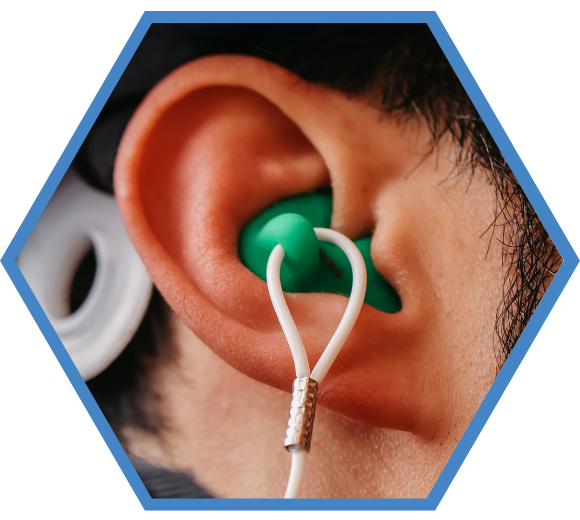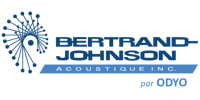CUSTOM EARPLUGS
Ear Impression Process
The first step in producing custom earplugs

By Jules Pouzot | Operations Manager
Taking ear impressions is the first step in the manufacture of customized earplugs. To ensure the manufacture of comfortable custom-made earplugs, it is essential that the impressions are taken correctly. This procedure is generally risk-free for workers, and only takes around ten minutes for each individual.
Material needed to complete the ear impressions
.png?width=728&height=300&name=Mat%C3%A9riel%20n%C3%A9cessaire%20(728%20x%20300%20px).png)
- Otoscope for visualizing the ear canal.
- Luminous stem for inserting protective padding.
- Protective absorbent cotton or foam.
- A 'gun' for mixing materials.
- Ear impression material.
- Syringe for inserting material into ear.
Preparing ears for hearing impressions
Before getting started, it's crucial to check that workers' ears are ready for the impression process. First, a visual inspection of the ears using an otoscope helps identify any contraindications, such as infection or perforation of the eardrum, which would necessitate postponing the procedure. Although some people are in the habit of using cotton buds to clean their ears, at Bertrand-Johnson Acoustique we advise against this practice, as it can be more harmful than helpful. However, if a person is known to produce excessive earwax and suspects a blockage, it is recommended that they consult a professional to remove it before proceeding with impressions.
Ear impressions in a five-step process
Step 1
Examination of the ear canal using an otoscope is an essential step to ensure safety and efficiency during ear impression taking. This procedure helps identify any abnormalities or conditions that could affect the process, such as an earwax plug that could block the canal, or an ear infection that could worsen if left untreated before the impression is taken. Performing this examination ensures that the ear canal is in good condition and ready for the procedure, while taking the necessary steps to inform the worker of any conditions identified, thus guaranteeing the individual's comfort and safety.
Step 2
Inserting a small foam or cotton plug is an important step in the ear impression process. This protective wadding, specially designed to be soft and non-irritating, plays a crucial role in protecting the delicate structures of the ear. In particular, the eardrum is particularly sensitive and requires special attention. Wadding acts as a protective barrier, preventing the impression material used to create a precise mold of the ear from coming into direct contact with the eardrum. This precaution is essential to prevent any risk of injury or discomfort during the procedure, ensuring a safe and comfortable experience for the individual.
Step 3
After preparing the necessary equipment, the impression paste is applied to the ear canal. This step is carried out using a suitable gun and syringe. The operator ensures that the paste is applied evenly and without excessive pressure, to accurately capture the unique shape of the ear canal. This precision is essential for the manufacture of tailor-made hearing protectors that will offer comfort and efficiency. Throughout this process, the operator remains attentive to the worker's reactions, ensuring his or her comfort and safety.
Step 4
The impression paste dries in the ear for about 5 minutes. During this time, it is important that the employee remains motionless and avoids speaking or opening his or her mouth. These precautions are necessary to ensure that the impression does not become deformed, which could compromise the precision of the customized hearing protection. Indeed, any movement of the jaw can alter the shape of the impression, making the molding less effective and potentially uncomfortable to wear.
Step 5
The impressions are gently removed from the ears to prevent any irritation to the sensitive structures of the ear. The operator then carefully examines the impressions for accuracy and integrity. These impressions are then combined with a detailed form completed by the worker, containing important information such as personal preferences and necessary technical specifications. This complete file is then prepared to be sent to the laboratory, where qualified technicians will use the data to begin the process of customizing the hearing aids.
Frequently Asked Questions
Ear Impressions
Ear impressions on-site are usually scheduled in groups of 15 minutes. Although the time spent is around 10 minutes per person, a few extra minutes are allowed for set-up. During this time, each person will be asked to fill in a form with their ID and preferences.
No. At Bertrand-Johnson Acoustique, we digitize workers' ear impressions and store them in our archives for three years. This makes it possible to reproduce earplugs without having to take new ear impressions.

Reduce noise exposure with customized plugs
Reinforce your prevention program with our custom-made earplugsthat offer optimum comfort and superior protection to prevent occupational deafness.

-1.png?width=144&height=72&name=BJA%20_%20Logo%20Color%20%20(1)-1.png)
